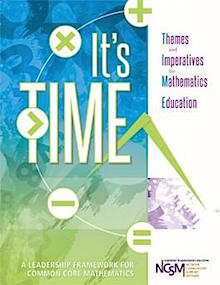It’s Time to Update Math Education
It’s TIME: Themes and Imperatives for Mathematics Education
By the National Council of Supervisors of Mathematics
(NCSM, 2014 – Learn more)

With the implementation of the Common Core State Standards and the included Mathematical Practices, one of the biggest challenges faced by district leaders and professional developers is changing teacher beliefs about how children learn math. This is particularly difficult in an age when both teachers and students are pressured to perform on high stakes assessments that may or may not reflect the ideals of the standards.
It’s TIME seeks to provide the guidance necessary to help districts achieve the goal of providing all students with equitable, high quality math instruction as they strive for increased mathematics proficiency and understanding for all. While it achieves the goal of laying out a framework for change, It’s TIME fails to address at least one major movement in the area of mathematics education.
Inside the book

The book goes on to address the importance of teacher content knowledge as well as pedagogical content knowledge and makes suggestions to leaders for increasing both of these as well as addressing the importance of using the CCSS-M to set reasonable grade level expectations. The standards are described as “a starting point with which to establish a local curriculum.”
The remainder of the book is dedicated to laying out what the authors consider to be imperatives for instruction and assessment practices as well as imperatives for systemic change. There is a heavy emphasis on assessment, using data from assessments, and providing teachers with professional development to fill gaps in content knowledge as well as data informed instructional decision-making.
Some problems not solved
The ideas addressed are solid and research based. The authors do an excellent job of painting a picture of the practices involved in having an effective school-wide (district-wide) mathematics program. However, It’s TIME falls short in its failure to address common challenges districts may face as they attempt to implement some or all of the suggested changes, such as time and funding for these changes to occur.
Another area in which the book falls short is its failure to acknowledge Response to Intervention (RtI) as a movement in education and the lack of current research to support effective implementation of RtI in mathematics. The book does offer suggestions for supporting struggling students, but uses the word “intensification” rather than intervention.
The suggestions involve using data that is already being collected in the form of teacher recommendations and classroom assessments to identify students and offer extra “intensified” experiences outside the regular classroom as a means of supporting their learning within the classroom. In this age of accountability, the recommendation to use somewhat informal bits of evidence to identify students who struggle and track their progress as they receive additional support is simply not sufficient.
A helpful framework
In short, It’s TIME is by no means comprehensive and brings no new information to the table. However, it is a good read that does a nice job of summarizing the elements of effective mathematics instruction and describing a framework for school-wide or district-wide systems that can lead to effective instruction and increased mathematics achievement for all students, provided sufficient resources are available.
Jami Garner is a PhD student in Math Education at the University of Tennessee Knoxville and also serves as the K-6 Mathematics curriculum coordinator for Oak Ridge Schools. She has served on the Tennessee Statewide Personnel Development Grant, providing professional development to teachers across the state on best practices for math instruction. Her research interests include student strategies for proportional reasoning and effective formative assessments, as well as math interventions and the implementation of RtI.


































